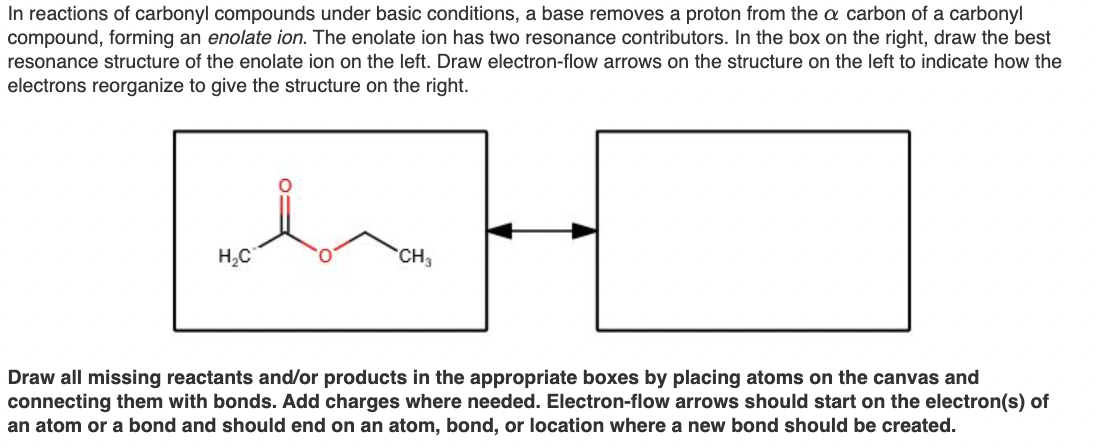compound, forming an enolate ion. The enolate ion has two resonance contributors. In the box on the right, draw the best esonance structure of the enolate ion on the left. Draw electron-flow arrows on the structure on the left to indicate how the electrons reorganize to give the structure on the right. H,C CH Draw all missing reactants and/or products in the appropriate boxes by placing atoms on the canvas and connecting them with bonds. Add charges where needed. Electron-flow arrows should start on the electron(s) of an atom or a bond and should end on an atom, bond, or location where a new bond should be created.
compound, forming an enolate ion. The enolate ion has two resonance contributors. In the box on the right, draw the best esonance structure of the enolate ion on the left. Draw electron-flow arrows on the structure on the left to indicate how the electrons reorganize to give the structure on the right. H,C CH Draw all missing reactants and/or products in the appropriate boxes by placing atoms on the canvas and connecting them with bonds. Add charges where needed. Electron-flow arrows should start on the electron(s) of an atom or a bond and should end on an atom, bond, or location where a new bond should be created.
Organic Chemistry: A Guided Inquiry
2nd Edition
ISBN:9780618974122
Author:Andrei Straumanis
Publisher:Andrei Straumanis
Chapter24: Carboxylic Acids & Derivatives
Section: Chapter Questions
Problem 9E
Related questions
Question
Please see attached

Transcribed Image Text:In reactions of carbonyl compounds under basic conditions, a base removes a proton from the a carbon of a carbonyl
compound, forming an enolate ion. The enolate ion has two resonance contributors. In the box on the right, draw the best
resonance structure of the enolate ion on the left. Draw electron-flow arrows on the structure on the left to indicate how the
electrons reorganize to give the structure on the right.
H,C
CH3
Draw all missing reactants and/or products in the appropriate boxes by placing atoms on the canvas and
connecting them with bonds. Add charges where needed. Electron-flow arrows should start on the electron(s) of
an atom or a bond and should end on an atom, bond, or location where a new bond should be created.
Expert Solution
This question has been solved!
Explore an expertly crafted, step-by-step solution for a thorough understanding of key concepts.
Step by step
Solved in 2 steps with 1 images

Knowledge Booster
Learn more about
Need a deep-dive on the concept behind this application? Look no further. Learn more about this topic, chemistry and related others by exploring similar questions and additional content below.Recommended textbooks for you

Organic Chemistry: A Guided Inquiry
Chemistry
ISBN:
9780618974122
Author:
Andrei Straumanis
Publisher:
Cengage Learning

Organic Chemistry: A Guided Inquiry
Chemistry
ISBN:
9780618974122
Author:
Andrei Straumanis
Publisher:
Cengage Learning